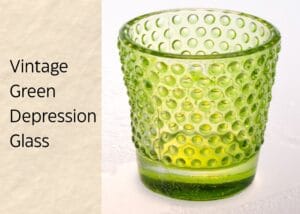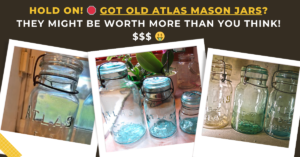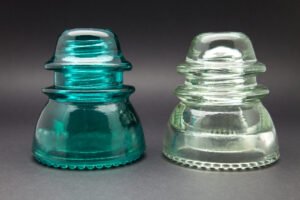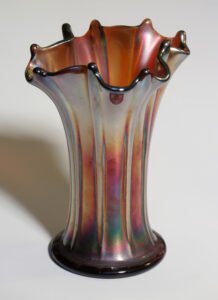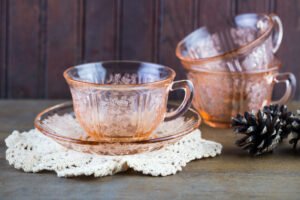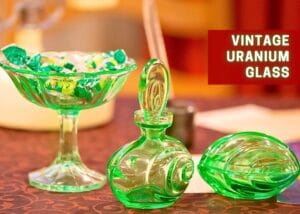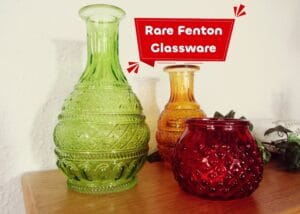Green Depression glass holds a special place in the American glassmaking scene. The second most popular color produced during the Depression era, green glass was made in over 100 major patterns between the late 1920s and early 1940s.
In this guide, I will share tips to spot authentic vintage green Depression glass, evaluate its value, and find some of the most valuable patterns that collectors regularly search for!
About Green Depression Glass
The name “Depression Glass” comes directly from its era, the Great Depression of 1929 to 1939. Traditional high-end glass and china were out of reach for most American families during this economic crisis.
So, glass makers, like Anchor Hocking and Jeannette, turned to mass-produced colored glassware. They used machine-pressed molding, which was a fast and inexpensive method, to mass-produce dinnerware. The result was thin, lightweight glass with unique flaws.
Green was one of the favorite colors of the era and one of the most abundantly released colors. Green Depression glass pieces remain collector favorites to this day due to their vibrant look and, of course, history!
5 Signs of Authentic Green Depression Glass
Authenticating Green Depression Glass means looking for the unique features of mass-produced 1930s glassware. Unlike fine crystal, Depression glass’s value and genuineness often lie in its imperfections.
Key Physical Features
Original green Depression glass from the 1930s has some unique physical characteristics that can easily distinguish it from modern replicas. These features are:
– Color & the UV Light Test:
Needless to say, green Depression glass is, well, green. But the shade of green can vary from pale yellow-green (aka “Vaseline Glass” among collectors) to deeper emerald tones.
And since most green Depression glass pieces contain trace amounts of uranium oxide, they tend to glow brilliant electric green or yellow-green under UV light. This fluorescence test is a strong indicator of real green depression glass.
Note: Depression glass differs because manufacturers added iron oxide along with uranium dioxide to get that green color, whereas Vaseline glass contains only uranium without iron oxide
– Weight and Texture:
Authentic Depression glassware pieces feel thin and lightweight. Manufacturers kept it that way to maintain translucency and hold down costs during tough economic times. Modern reproductions, on the other hand, are often thicker and heavier than originals.
Also, the surface of original green Depression glass may also show slight waves or ripples from the rapid cooling process used in the 1930s.
Markings (Barely There!)
Maker’s markings can be a great identification tool, but green depression glass is rarely marked by manufacturers. Most companies either didn’t mark their wares or used paper labels that disappeared decades ago.
But there are a few exceptions. The Federal Glass Company, for instance, often used a shield with a capital “F” in the center. But they only marked some pieces and not others, so you can find cups, saucers, and sherbets both with and without the F mark.
Similarly, some depression glass pieces from Hazel-Atlas may show an “H” over an “A” mark, starting around 1932.
But don’t panic if your piece has no mark! You can still identify and authenticate unmarked pieces based on other physical features and patterns.
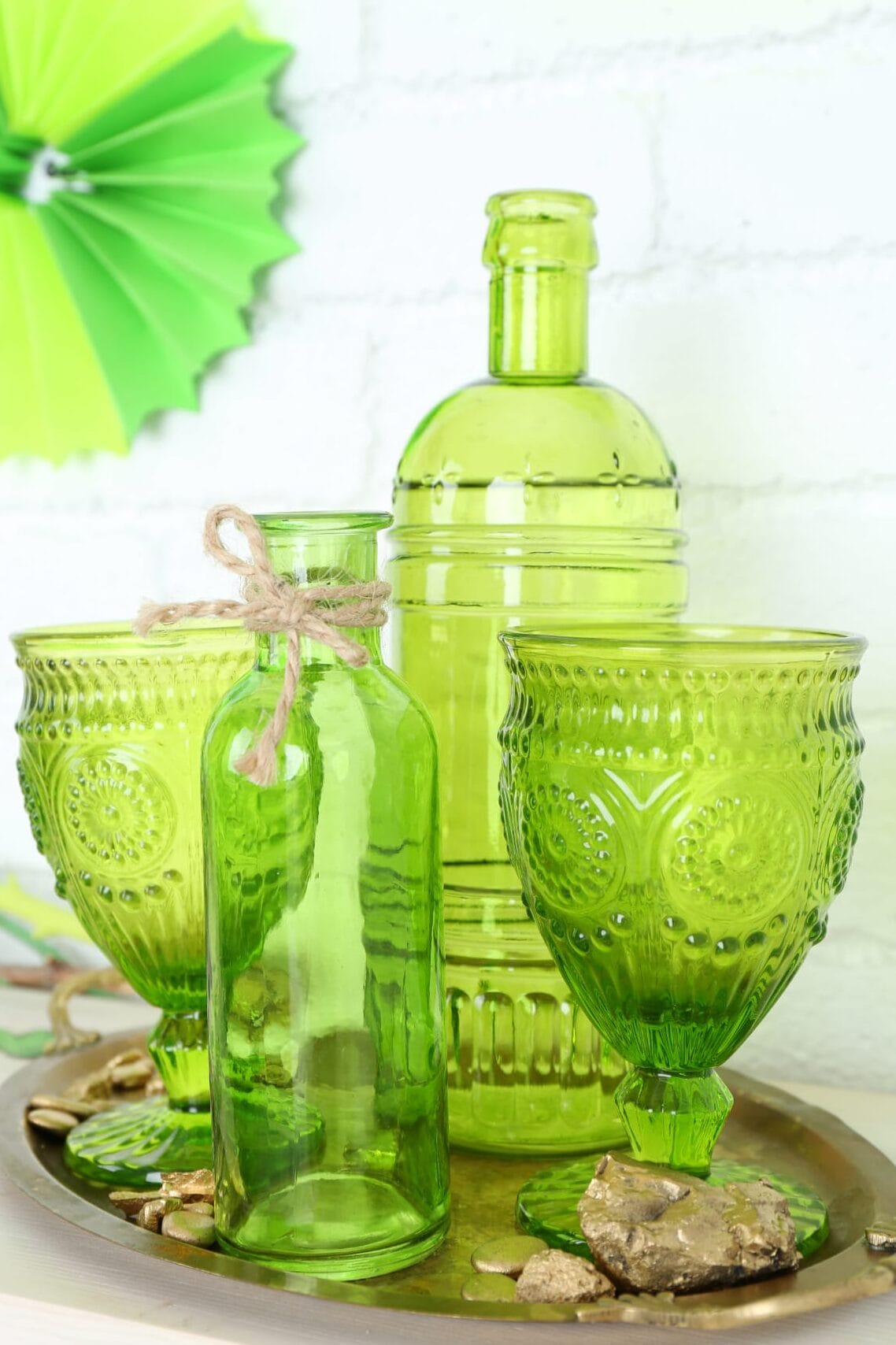
Makers & Patterns
Since most Depression Glass pieces are unmarked, identification relies on recognizing the pattern and characteristic piece shapes.
Keep in mind that Depression glass has raised patterns pressed into the surface, unlike fancier “Elegant glass” which features recessed, etched designs. Run your fingers across the piece’s surface, and you should feel those raised design elements clearly.
You can easily identify the piece if you know the pattern and which company made it and when. Below are some renowned glassware companies and their most valuable green patterns:
1. Federal Glass Company:
Founded in 1900, Federal became the heavyweight champion of Depression glass by the 1930s, turning out memorable mold-etched pieces. Their green patterns include some real standouts:
- Sharon (Cabbage Rose) (1935-1939): Features large cabbage rose bouquets between vertical dividers.
- Georgian (Lovebirds) (1931-1936): One of Federal’s pricier patterns, has rounded triangular cartouches with two birds alternating with baskets.
- Parrot (Sylvan) (1931-1932): Has three parrots on palm tree branches; it was only produced for one year in green and amber.
- Madrid (1932-1939): Elaborate baroque-style pattern with beading, ribbons, scrollwork, and florals produced in amber, green, crystal, and rare blue.
2. Hazel-Atlas Glass Company:
This mega company was founded in 1902 as a merger of several companies. Hazel-Atlas specialized in machine-molded Depression glass and occasionally used an “H” over an “A” mark to differentiate their pieces.
- Royal Lace (1934-1941): The most sought-after pattern, known for its unique lace-like border.
- Florentine No. 1 and No. 2 (1932): These are interesting because Hazel-Atlas used the same floral design on two completely different shapes—one round/oval and one angular six-sided.
- Moderntone (1934-1943): Art Deco pattern that became the “Ships” pattern when they added sailboat decals.
3. Anchor Hocking Glass Company:
Founded in 1905 in Lancaster, Ohio, Anchor Hocking became a major force in household glassware. The company developed heat-proof glass and created famous Depression glass patterns, like:
- Cameo (Ballerina/Dancing Girl) (1930-1934): Features a dancing woman etched into glass surrounded by scrolls and florals.
- Mayfair (Open Rose) (1931-1937): A detailed floral design. It was made in pink, blue, yellow, and green.
- Princess (1931-1934): Features feminine, soft, chiseled edges.
4. Jeannette Glass Company:
Started in 1888 in Jeannette, Pennsylvania, as a bottle manufacturer, Jeannette Glass Company became known for affordable Depression glass. The company also continued making colored and iridized glass through the 1970s before closing in 1983.
Some of Jeannette’s most valuable green patterns are:
- Cherry Blossom (1930-1939): Features delicate cherries, leaves, and flowers, produced in pink, blue, green, crystal, and other shades. Original Cherry Blossom leaves are very detailed with serrated edges and varying vein thicknesses.
- Adam (1932-1934): Art Deco pattern featuring clean designs with long ribs and delicate floral edge motifs.
- Floral (Poinsettia): Raised floral motifs, produced in various colors, with green being valuable.
5. MacBeth-Evans Glass Company:
MacBeth-Evans is famous for its thin, delicate glass. It produced the popular American Sweetheart pattern from 1930 to 1936, its most popular pattern. Recognize it by the scalloped rims and the highly filigreed etching.
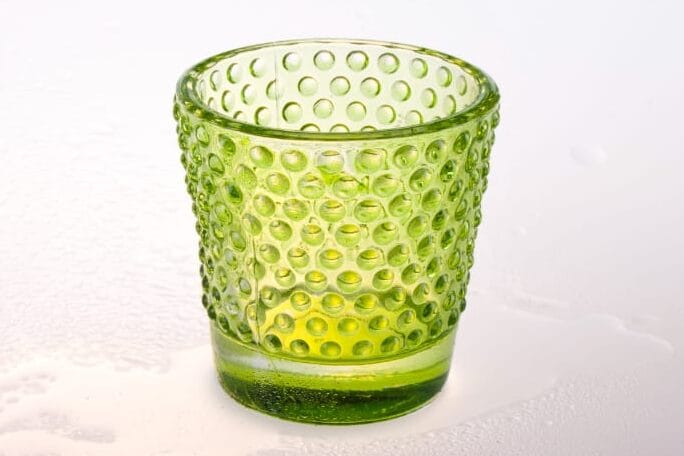
Authenticity Signs
Unlike most antiques, where flaws kill value, certain imperfections actually prove the authenticity of vintage Depression glass.
- Tiny air bubbles throughout the glass, about the size of a period, are characteristic of authentic pieces. Reproductions generally don’t have these.
- Visible Seams: Fast production meant glasses sometimes slipped in molds, creating noticeable seams you can see and feel, mostly on the underside.
- Straw Marks: These are small lines at the base that came from the cast-iron molds used to make the glass. Also, original Depression glass was laid to dry on beds of straw, leaving light indentations.
- Inconsistent Coloring: Color variations in one piece or between pieces in a set are common.
- Molding Flaws: Rough spots, unevenness, and tiny molding flaws occur frequently.
- Wear of Use: Since Depression glass was used for daily meals, authentic pieces often have scratches from knives and flatware.
Finding the Value of Vintage Green Depression Glass!
Depending on several factors (discussed below), Depression glass prices can range from $5 to $250. Rare pieces may sell for several hundred dollars. Let’s understand what really drives these values.
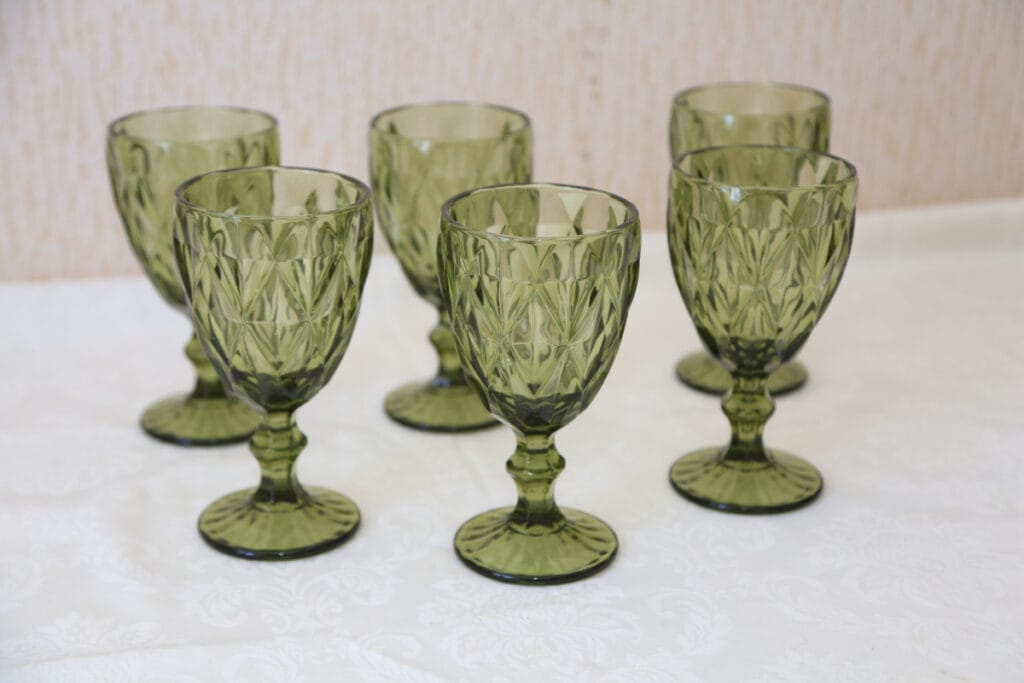
1. Assess the Condition
Since green Depression glass is quite common, collectors only pay for “mint” glass, pieces with no damage or repairs.
While minor production flaws (bubbles, seams, straw marks) are good signs, serious damage from use, such as chips, cracks, deep scratches, and visible or amateur repair, tanks the value.
2. Identify the Pattern & Makers
The value of green Depression glass directly depends on the pattern and maker. Pieces featuring the most popular patterns, like Jeannette’s “Cherry Blossom,” Hazel Atlas’s “Royal Lace,” or Federal’s “Parrot” (Sylvan) are worth the most.
Common green glass patterns like Anchor Hocking’s “Cameo” hold steady, modest values.
So, make sure to identify the piece’s pattern and maker! You can also refer to a company’s reference book to help you identify the patterns.
3. Check the Rarity
A common green Depression glass piece is usually less valuable than a rare piece. The rarity can be anything, a short-lived pattern (like Federal “Parrot”), color rarity within patterns, or specific hard-to-find forms and shapes (like butter dishes, sugar bowls, and pitchers).
Checking rarity will require you to know a pattern’s production history and manufacturer details.
4. Look for Complete Sets
Some patterns were produced as complete dinnerware sets, while others had limited piece selections. Mostly, complete or nearly complete sets in specific patterns and individual colors command significantly higher values than individual pieces.
But unusual pieces outside the typical dinnerware set, like things beyond dinner plates, teacups, saucers, and bowls, can also command higher prices because they’re more unique.
Rare Green Depression Glass Pieces (12 Patterns to Find)
The following list shows you some of the most popular and valuable green Depression glass patterns that have actually sold for hundreds of dollars, and how to spot them.
1. “Georgian Love Birds” Dinnerware Set by Federal

This is a complete dinnerware set (40+ pieces) from Federal Glass Company featuring their iconic “Georgian” pattern. It features pairs of parakeets perched in rounded triangle cartouches around each rim, which is why collectors also call it the “Lovebirds” pattern.
The design alternates birds with decorative baskets, connected by delicate leaf swags, with a medallion at the center. The pattern’s popularity and completeness of this set are why it sold for a stunning price of $745!
2. “Sylvan/Parrot” Green Hot Tiles by Federal Glass Co.
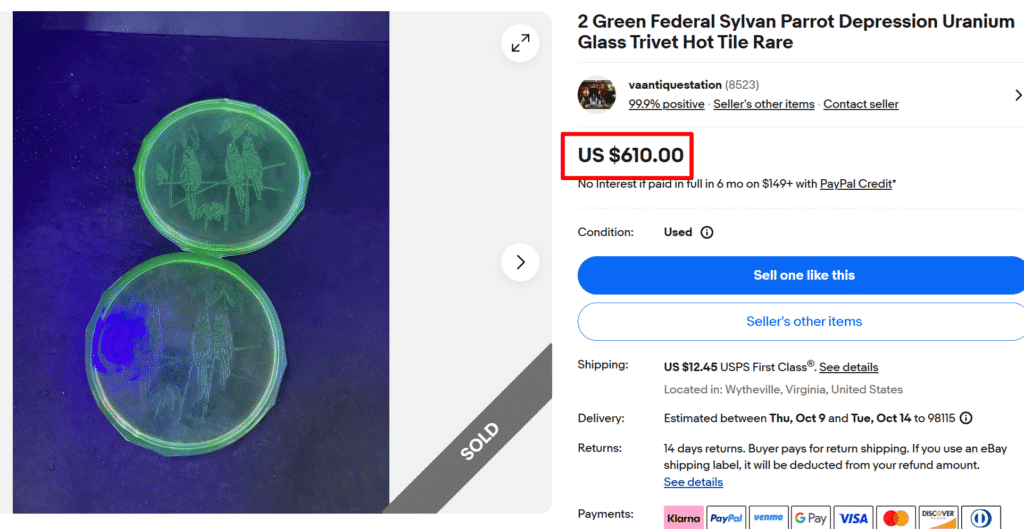
This set of hot tiles or trivets features Federal Glass Company’s most renowned patterns, the “Sylvan” pattern (better known as “Parrot”). It was made for just two short years, 1931 to 1932, which makes it one of the rarest Depression glass patterns you’ll find.
The pattern shows two large embossed parrots perched on branches with palm tree decorations in each corner. These pieces are quite hard to find because of the brief production run. As a result, the value can range from $100 to $700 in good condition.
3. “Fine Rib” Green Pitcher Set by Hazel Atlas
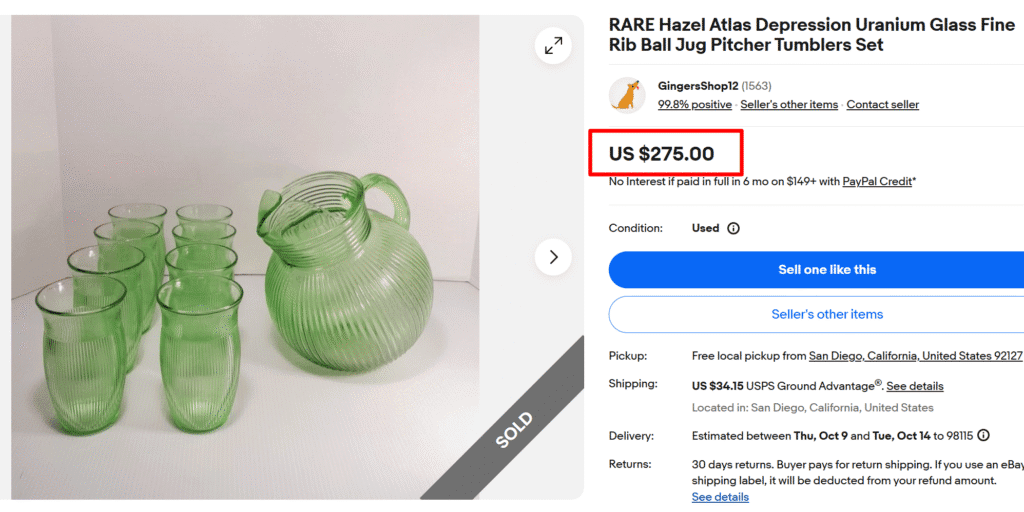
This set is like a quintessential American summer memory piece. The pitcher and tumbler set features Hazel Atlas’s “Fine Rib” pattern, known for its vertical ribbing that runs down the piece’s height. This Art Deco-style design is popular among collectors, making these pieces collectible. Make sure to look for a single seam on the bottom and straw marks.
4. “Cherry Blossom” Cups & Saucers by Jeanenette Glass
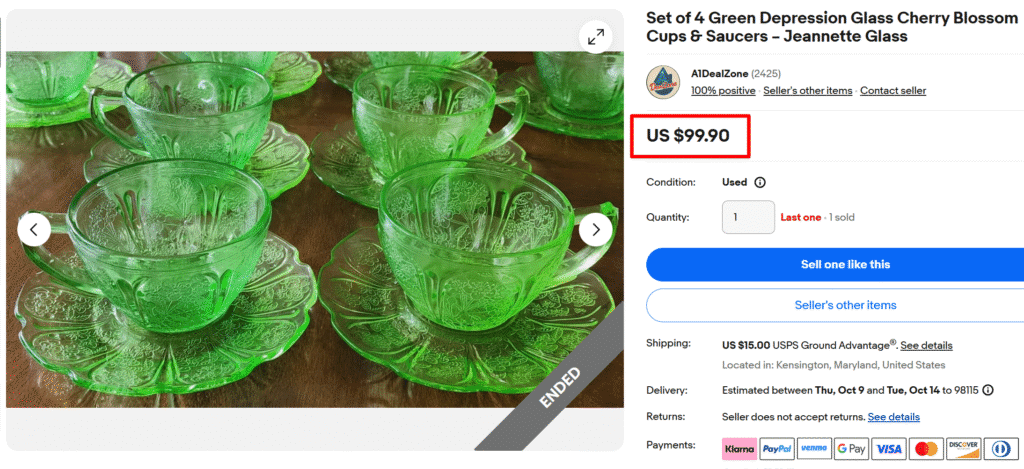
Cherry Blossom is Jeannette Glass’s longest-running Depression pattern, from 1930 to 1938. But the green glass production stopped in 1935, making these pieces scarcer than pink.
Just like the name, the design must show cherry blossoms around the rims with cherries on the bases. Also, authentic pieces have stems that connect to the leaves and blossoms, while fakes have floating designs.
5. “Dogwood” Green Serving Bowl by MacBeth Evans
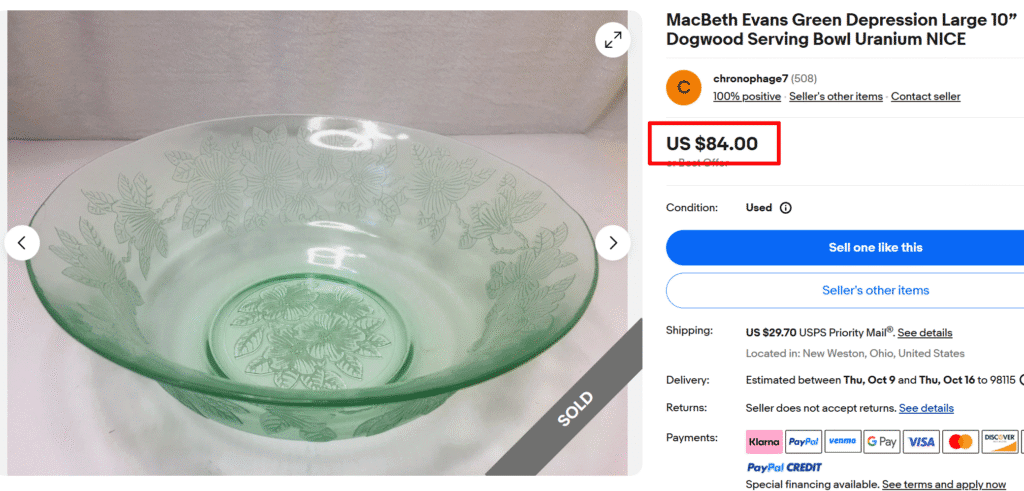
This large serving bowl features MacBeth-Evans’s “Dogwood” pattern (sometimes called “Apple Blossom” or “Wild Rose” It was produced from 1930 to 1934 and features a delicate mold-etched design of four-petaled flowers and leaves.
Green Dogwood is significantly harder to find than pink, making it more valuable. Single pieces like this can be worth $20 to $100, but sets can go even higher.
6. “Colonial Block” Green Glass Goblets by Hazel Atlas

Another popular pattern of Hazel-Atlas made from 1930 to 1935! You can spot the “Colonial Block” design by its geometric Art Deco design featuring raised block panels around the sides. Since it’s a more common pattern, mint pieces or sets can generally fetch $10 to $150.
7. Large Green Depression Glass Fish-Turtle Bowl
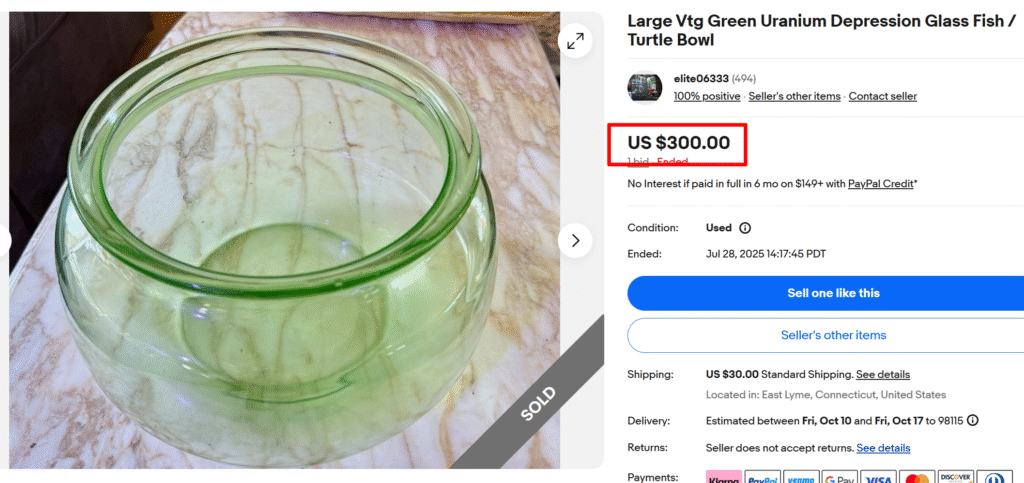
Now this piece does not have any specific pattern, but still sold for a good price of $300 because of its size; it’s about 6-7 inches in diameter, bigger than most.
These round bowls were extremely popular during the 1930s and 1940s for keeping goldfish or other relatively small pets. They do not typically bear maker’s marks, but the quality of the glass, that signature glow, and the air bubbles can tell you a lot.
8. “Madrid” Green Tumblers by Federal Glass Company
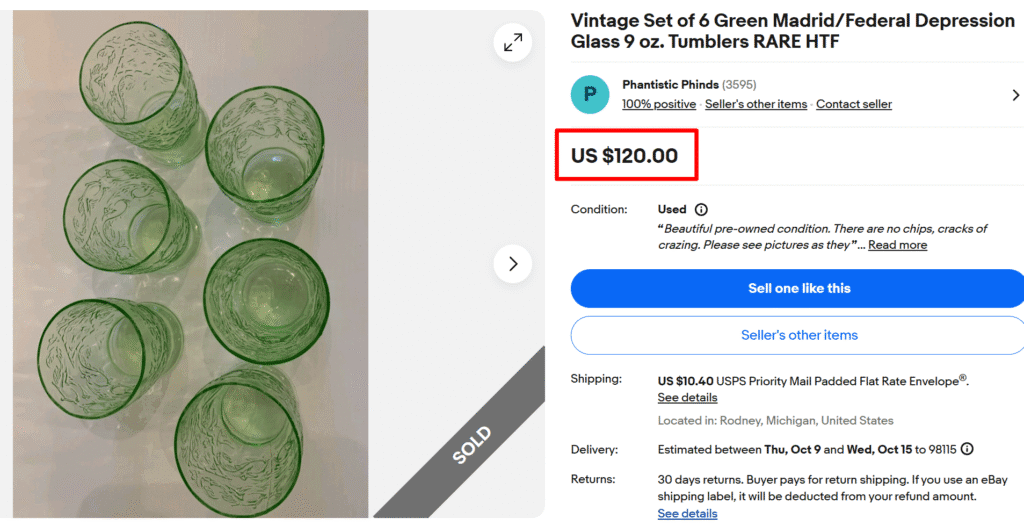
Federal Glass’s Madrid pattern, known for delicate scrolls, flowers, and small geometric elements, was in production from 1932 to 1939. Tumblers were popular free giveaways, so they can be common. Nonetheless, the pattern holds a timeless value of $15 to $200, based on the number of pieces and condition.
9. “Ballerina Cameo Green” Tumblers by Anchor Hocking
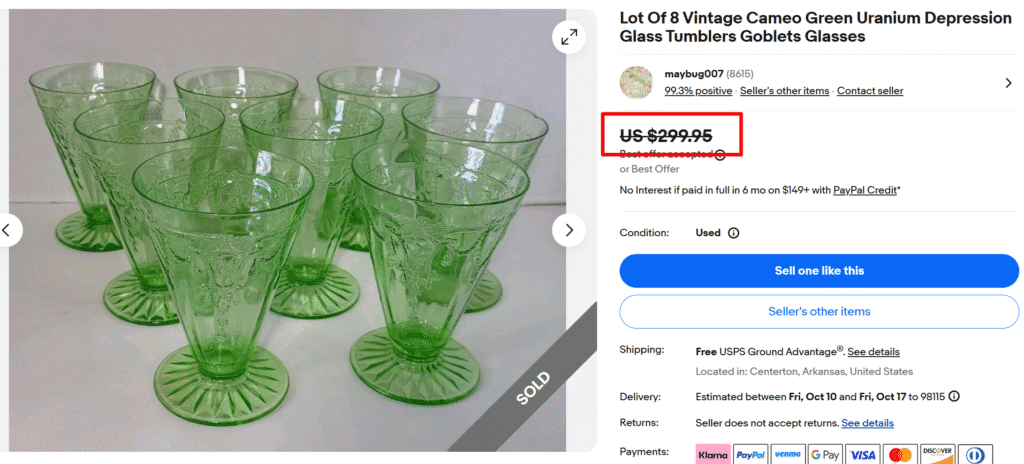
This goblet set features Hocking Glass Company’s most popular pattern, “Cameo” (1930 to 1934). It features the famous “Dancing Girl” or “Ballerina” design etched into the glass with scrollwork.
Although green Cameo pieces are the most common color, they remain popular with collectors. Individual pieces usually go for $40 to $50 in good condition, while full sets like this can fetch a few hundred dollars.
10. “Sharon Cabbage Rose” Green Cups by Federal Co.
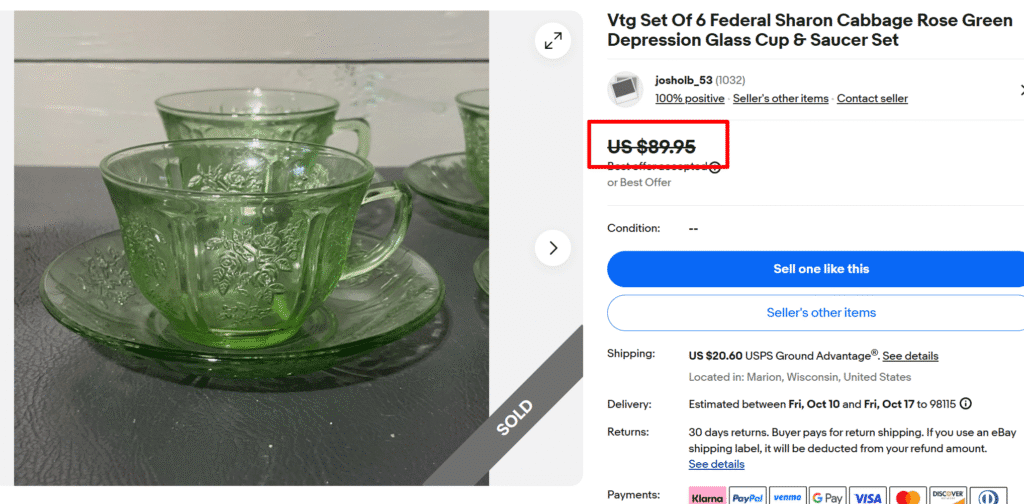
Federal Glass Company made the Sharon pattern, called “Cabbage Rose,” from 1935 to 1939. It came in amber “Golden Glow,” pink “Rose Glow,” and the hardest-to-find “Springtime Green.” Green Sharon is the most difficult color to find, making these pieces particularly valuable for collectors!
11. “Florentine” Salt & Pepper Shakers by Hazel Atlas
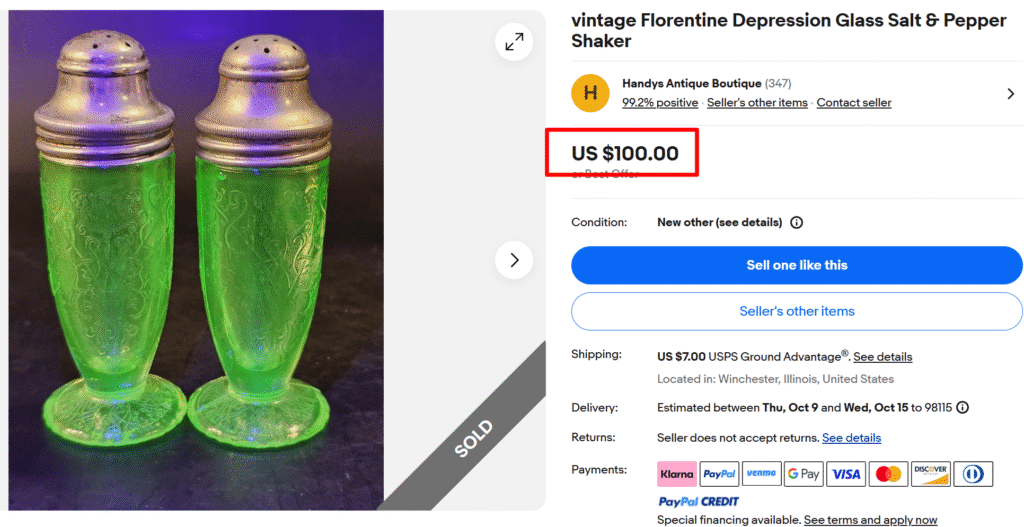
These shakers were made by Hazel Atlas Glass Company in their popular “Florentine” pattern, also known as “Old Florentine” or “Poppy No. 1.” You can spot it by its scalloped bases and detailed floral (poppy) design.
Shakers usually come with metal screw-top lids, which show signs of wear and usage. Pairs with original tops in good condition can sell for $60 to $150!
12. “Princess” Candy Dish by Anchor Hocking
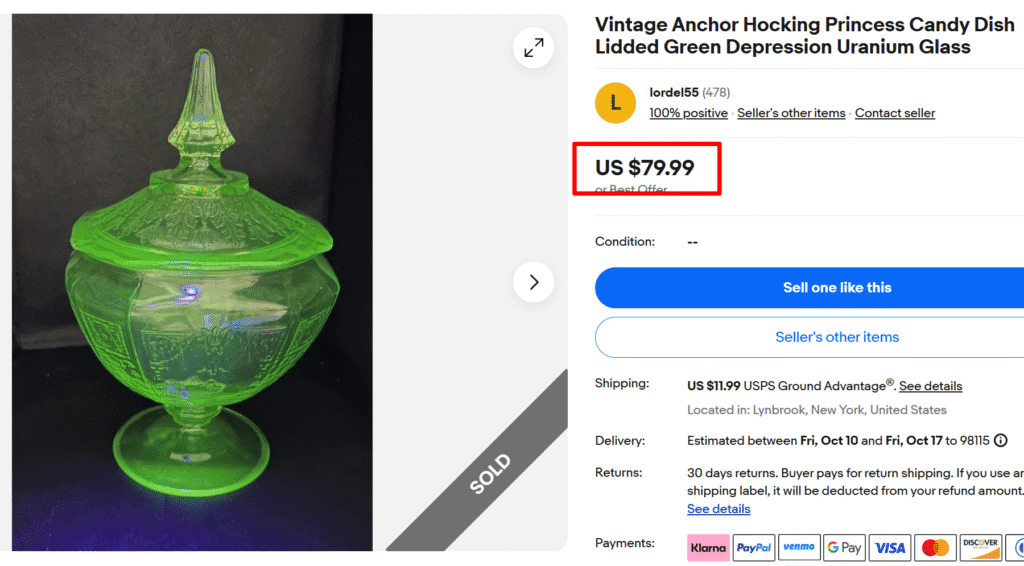
Anchor Hocking made the Princess pattern from 1931 to 1934 in pink, green, and topaz. The pattern is known for its scalloped edges and elegant design. This green lidded candy dish with a distinctive pointed top and ornate pedestal base sold for almost $80 due to its large size and pattern popularity!
Note: This article is intended for informational, educational, and entertainment purposes only. Some images are illustrative and may not represent actual brands, products, or related entities. All trademarks, product names, brand logos, packaging, and other intellectual property referenced remain the exclusive property of their respective owners. Any brand mentions or references are provided solely for descriptive and educational context and do not imply any formal or commercial association.

